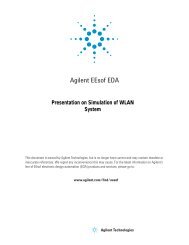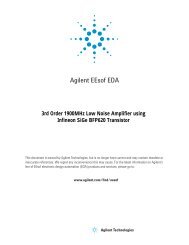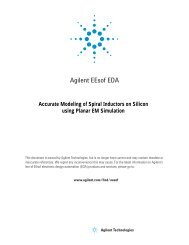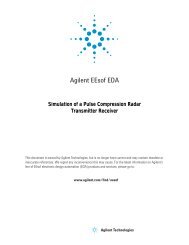Agilent 34970A/34972A Data Acquisition / Switch Unit
Agilent 34970A/34972A Data Acquisition / Switch Unit
Agilent 34970A/34972A Data Acquisition / Switch Unit
Create successful ePaper yourself
Turn your PDF publications into a flip-book with our unique Google optimized e-Paper software.
Chapter 5 Theory of Operation<br />
Internal DMM<br />
In the DC current function, a current is applied between the Input I and<br />
LO terminals. Ranging is accomplished by relay K102 and amplifier gain<br />
switching in U101. Since a known resistor (the shunt resister) is<br />
connected between these terminals, a voltage proportional to the<br />
unknown current is generated. The voltage sensed at R121 is measured<br />
by the multimeter’s DC circuitry. The table below illustrates the DC<br />
current measuring function configurations.<br />
DCI Range<br />
1A<br />
100 mA<br />
10 mA<br />
Shunt<br />
Resistor<br />
0.1<br />
5.1<br />
5.1<br />
U101-10<br />
Input<br />
100 mV<br />
510 mV<br />
51 mV<br />
Amplifier<br />
Gain<br />
x100<br />
x10<br />
x100<br />
ADC Input<br />
10 V<br />
5.1 V<br />
5.1 V<br />
Resistance measurements are made by applying a known current<br />
through an unknown resistance. The resulting voltage drop across the<br />
unknown resistance is then measured by the multimeter’s DC circuitry.<br />
The 100 M range is measured using the known internal 10 M<br />
resistance (U102A) in parallel with the unknown input resistance while<br />
applying the 500 nA current source. The result is computed from the<br />
measured data. The internal 10 M resistance is determined whenever a<br />
zero calibration is performed.<br />
In the 2-wire ohms function, the voltage drop is measured across the<br />
Input HI and Input LO terminals. In the 4-wire ohms function, the voltage<br />
is measured across the HI Sense and LO Sense terminals. Lead<br />
resistances in series with the current source (Input HI–LO) are not part of<br />
the final measurement. However, they do reduce the available current<br />
source compliance voltage for the resistor under test. The ohms current<br />
source will become non-linear when the compliance voltage limit is<br />
exceeded. The full scale voltage developed across the unknown resistor<br />
and the DC amplifier gain for each resistance range are tabulated below.<br />
Ohms Range Voltage Across R Amplifier Gain ADC Input<br />
100 <br />
1 k to 100 k<br />
1 M<br />
10 M<br />
100 M<br />
100 mV<br />
1 V<br />
5 V<br />
5 V<br />
4.5 V<br />
x100<br />
x10<br />
x1<br />
x1<br />
x1<br />
10 V<br />
10 V<br />
5 V<br />
5 V<br />
4.5 V<br />
142

















